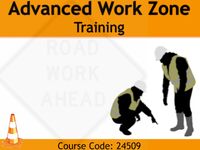Difference between revisions of "616.22 Advanced Work Zone Training"
m (Per WZQC, updated training link) |
m (→Advanced Work Zone Training for MoDOT Maintenance: updated per RR3776) |
||
| (5 intermediate revisions by 2 users not shown) | |||
| Line 1: | Line 1: | ||
| − | [[image: | + | [[image:awt_feb-2023.jpg|right|200px|link=https://modotgov.sharepoint.com/:p:/r/sites/SM/Training/Published%20Training%20Presentations/AdvancedWorkZone.pptx?d=w299d7cf2a94d4fab83dce3c2651d4ca8&csf=1&web=1&e=fvJRWP]] |
| − | {|style="padding: 0.3em; margin- | + | {|style="padding: 0.3em; margin-right:15px; border:1px solid #a9a9a9; text-align:center; font-size: 95%; background:#f5f5f5" width="260px" align="left" |
|- | |- | ||
|'''Training Course''' | |'''Training Course''' | ||
|- | |- | ||
| − | |[ | + | |[https://modotgov.sharepoint.com/:p:/r/sites/SM/Training/Published%20Training%20Presentations/AdvancedWorkZone.pptx?d=w299d7cf2a94d4fab83dce3c2651d4ca8&csf=1&web=1&e=fvJRWP Advanced Work Zone Training] |
|- | |- | ||
|''Internal Use Only'' | |''Internal Use Only'' | ||
| Line 11: | Line 11: | ||
MoDOT is committed to providing safe and efficient movement of both motorized and non-motorized traffic through or around temporary traffic control work zones and providing protection for workers and equipment located within those work zones. MoDOT focuses its resources to emphasize roadway visibility in temporary traffic control work zones and traffic flow through those work zones. | MoDOT is committed to providing safe and efficient movement of both motorized and non-motorized traffic through or around temporary traffic control work zones and providing protection for workers and equipment located within those work zones. MoDOT focuses its resources to emphasize roadway visibility in temporary traffic control work zones and traffic flow through those work zones. | ||
| − | To better educate those responsible for designing and managing temporary traffic control in work zone safety considerations, MoDOT has created this course, “Advance Work Zone Training”. The course is the third part of a curriculum pertaining to work zones. Upon completion of the course, the participants will be certified as a | + | ===Advanced Work Zone Training for MoDOT Maintenance=== |
| + | |||
| + | To better educate those responsible for designing and managing temporary traffic control in work zone safety considerations, MoDOT has created this course, “Advance Work Zone Training”. The course is the third part of a curriculum pertaining to work zones. Upon completion of the course, the participants will be certified as a “[https://epg.modot.org/forms/general_files/SM/Work_Zone_Specialist_Role_and_Training_Requirements.pdf Work Zone Specialist]” (WZS). MoDOT will have a WZS involved in every aspect of the traffic control plan from preliminary to post-construction work. MoDOT employees working in the capacity of a WZS, will be re-certified every four years starting April 2016. | ||
The WZS’ actions directly impact the mobility and safety of a work zone. The WZS is responsible for knowing applicable standards, guidelines, interpreting plans, specifications, coordinating temporary traffic control requirements, meeting the requirements of the contract or field operation guidelines and supervising traffic control personnel. | The WZS’ actions directly impact the mobility and safety of a work zone. The WZS is responsible for knowing applicable standards, guidelines, interpreting plans, specifications, coordinating temporary traffic control requirements, meeting the requirements of the contract or field operation guidelines and supervising traffic control personnel. | ||
| Line 18: | Line 20: | ||
Contractors are required to obtain training for their work zone specialists in the principles of proper temporary traffic control in accordance with Chapter 6 of the MUTCD and [http://www.modot.org/business/standards_and_specs/SpecbookEPG.pdf#page=9 Sec 616.3.3]. Re-certification is required every four years starting April 2016. | Contractors are required to obtain training for their work zone specialists in the principles of proper temporary traffic control in accordance with Chapter 6 of the MUTCD and [http://www.modot.org/business/standards_and_specs/SpecbookEPG.pdf#page=9 Sec 616.3.3]. Re-certification is required every four years starting April 2016. | ||
| − | |||
| − | |||
| − | |||
[[Category:616 Temporary Traffic Control]] | [[Category:616 Temporary Traffic Control]] | ||
Latest revision as of 09:05, 22 September 2023
| Training Course |
| Advanced Work Zone Training |
| Internal Use Only |
MoDOT is committed to providing safe and efficient movement of both motorized and non-motorized traffic through or around temporary traffic control work zones and providing protection for workers and equipment located within those work zones. MoDOT focuses its resources to emphasize roadway visibility in temporary traffic control work zones and traffic flow through those work zones.
Advanced Work Zone Training for MoDOT Maintenance
To better educate those responsible for designing and managing temporary traffic control in work zone safety considerations, MoDOT has created this course, “Advance Work Zone Training”. The course is the third part of a curriculum pertaining to work zones. Upon completion of the course, the participants will be certified as a “Work Zone Specialist” (WZS). MoDOT will have a WZS involved in every aspect of the traffic control plan from preliminary to post-construction work. MoDOT employees working in the capacity of a WZS, will be re-certified every four years starting April 2016.
The WZS’ actions directly impact the mobility and safety of a work zone. The WZS is responsible for knowing applicable standards, guidelines, interpreting plans, specifications, coordinating temporary traffic control requirements, meeting the requirements of the contract or field operation guidelines and supervising traffic control personnel.
Advanced Work Zone Training for Contractors
Contractors are required to obtain training for their work zone specialists in the principles of proper temporary traffic control in accordance with Chapter 6 of the MUTCD and Sec 616.3.3. Re-certification is required every four years starting April 2016.
